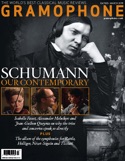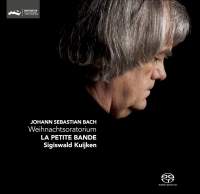Texte paru dans: / Appeared in: |
|
|
Outil de traduction (Très approximatif) |
|
|
Reviewer: Jonathan Freeman‑Attwood
Sigiswald Kuijken’s recent series of selected cantatas yielded many probing readings, especially in the more intimate works. These are the contexts where La Petite Bande best harness their collective expressive potential and get behind the notes without the distraction of discomfort or imbalance – whether induced by the composer’s demands or Kuijken’s own fairly entrenched views on performance practice, delivery of text and so on.
This reading of the Christmas Oratorio exhibits many of Kuijken’s most compelling qualities with his quietly authoritative, steady and organic understanding of how these six ‘tableaux’, unified and discrete in one, form a uniquely patient and kaleidoscopic Bachian festive narrative. As ever, the embedded timbral refinement of the instrumental palette makes its presence felt at every turn, the oboes touchingly effective in their bucolic overtones, the strings articulated with breathtaking élan (and, often, with deceptively wonderful textural doublings and juxtapositions with the wind, as in the opening of ‘Und es waren Hirten’) and the trumpets without ‘modern’ tuning holes making a quite eerily timeless impact in their effortless virtuosity, especially in the elegantly consorting framing choruses of Part 6.
To understand what underpins Kuijken’s serious approach to Bach is to be reminded that his pioneering historical instincts are increasingly left to speak for themselves. The arias are often outstanding. Petra Noskaiová is always an arresting singer but she shouldn’t be allowed to sing flat in her great slumber aria in Part 2. The highlights include superb coloratura in ‘Frohe Hirten’ from Stephan Scherpe and Jan Van der Crabben’s beautifully lucid account of ‘Erleucht’.
Irrespective of historical evidence, the balance of one-to-a-part voices presents particular challenges, and it only takes one singer to be ill-equipped to wrongfoot the whole. Such is the case here, sadly, with a brittle soprano lacking the necessary capacity to blend (with either too much fast vibrato or none at all) and tune, the latter a problem further exacerbated by the struggle to negotiate the desirable roughage of the horns in ‘Fallt mit danken’. For all the many fine attributes in this new reading, this is enough of a drawback to place it quite a distance below the frontrunners of Harnoncourt, Fasolis, Werner and, more recently, Stephen Layton. |
|
|
|
|
|
Cliquez l'un ou l'autre
bouton pour découvrir bien d'autres critiques de CD |
|




